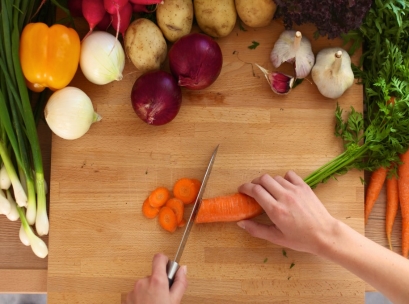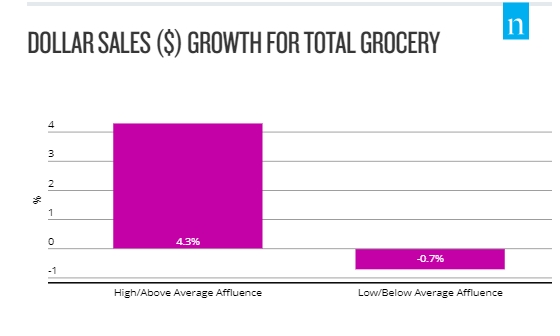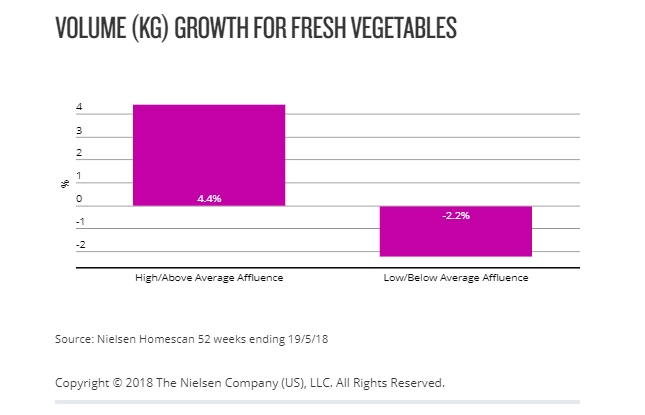 Affluence, a calculation based on income, number of children and household size reveals a lot about purchasing power. But how does affluence affect how many vegetables Australians eat? Can Australian shoppers reach their “five a day” on any budget?
Affluence, a calculation based on income, number of children and household size reveals a lot about purchasing power. But how does affluence affect how many vegetables Australians eat? Can Australian shoppers reach their “five a day” on any budget?
Millennials and high income households indicate a greater willingness to pay a premium for products that have perceived health benefits and/or offer superior quality.
However, the picture is not so rosy for less affluent households. With wage growth remaining weak and living costs rising, many households are under significant financial pressure.
Currently, affluent households are driving growth in overall grocery sales and they are also the sole driver of fresh vegetable growth in Australia, with the volume of fresh vegetables purchased by affluent households up 4.4% over the past year.
Despite health being a top concern among Australians, there are disparities between what households of varying affluence buy. In contrast to grocery growth for affluent households, grocery purchases by low and below average affluence households did not grow over the past year, with total dollar sales remaining relatively flat at -0.7%. Collectively these less affluent households actually purchased fewer fresh vegetables over the last year.
AFFLUENCE AND FOOD CHOICES
Affluence has also influenced how households allocate their grocery budget. High affluence households spent 8% of their total grocery spend on fresh vegetables, whereas households with low affluence allocated just 6.2% of their total grocery spend to fresh vegetables.
There are also some big differences when it comes to the type of vegetables purchased. High affluence households are more likely to have purchased higher priced items such as fresh herbs, pre-prepared vegetables and asparagus. In contrast, low affluence households are more likely to have purchased economical items such as potatoes and cabbage.
COMPLEX AND SURPRISING DRIVERS BEYOND PRICE
Nielsen Homescan reports significant differences in the average price households of differing affluence levels paid for fresh vegetables over the past year – a gap of over $1 per kilogram.
The differing price sensitivities of high and low affluence households does impact product choice, however the drivers are complex. For example:
- Salad: High affluence households purchase more than we would expect when it comes to higher priced convenience items like packaged salads (baby spinach, rocket and mixed leaf bags) and pre-mixed items like coleslaw, kale slaw and Asian slaw. In contrast, low affluence households are more likely to choose head lettuces such as iceberg which are typically a cheaper option on a per kilogram basis.
- Organic vegetables: Surprisingly, when it comes to organics, we see that despite typically being priced at a premium, low affluence households are actually much more likely to purchase organic vegetables.
THERE’S NO SILVER BULLET FOR A HEALTHY DIET
Many households still fall short in terms of the recommended dietary guidelines of five serves of vegetables each day. If product development innovations only focus on the development of premium options, these innovations will not support low affluence households so that they too can increase their consumption of healthy foods.
One strategy with a positive impact on vegetable purchasing by low affluence households is selling imperfect produce at a discount. Imperfect Picks (Harris Farm) and the Odd Bunch (Woolworths) make it possible for less affluent shoppers to purchase vegetables they would normally be price sensitive to. In Woolworths, this creative strategy has seen low affluence households purchasing more of the Odd Bunch vegetable range than we would expect, whereas high affluence households purchased less than we would expect them to.
Affluence certainly does impact the foods we eat and there is much work to do to close the gap between the current level of vegetable consumption and recommended dietary guidelines. Innovations that make healthy food more convenient will appeal to affluent shoppers, making it easier for them to increase their vegetable consumption. While the factors are complex for policy makers, retailers and growers, strategies that make vegetables more accessible for low affluence households are essential to increasing vegetable consumption amongst this group.
Chanel Day is the Associate Director and Tammy Tan, Senior Client Service Executive at Nielsen Australia.



















